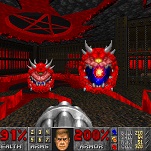
Every Friday, A.V. Club staffers kick off the weekend by taking a look at the world of gaming, diving in to the ideas that underpin the hobby we love with a bit of Game Theory. We’ll sound off in the space above, and invite you to respond down in the comments, telling us what you’re playing this weekend, and what theories it’s got you kicking around.
Video games have a complicated relationship with their own history. The most basic version of gaming archeology, in 2024, tends to come off in the most mercenary of ways: Studios and publishers selling the public slightly polished versions of 5-year-old games designed to be modestly “remastered” to work on new consoles, where they’ll sit in your digital library right next to three other versions of the exact same game. On the far side of capitalism, meanwhile, fan efforts to keep old video games playable and available—abandonware, emulation, fan remakes, etc.—exist permanently in a legal gray area, always just a single cease and desist letter away from vanishing into the ether. In the middle ground, though, there do exist teams working to not just re-sell old games, but to preserve and curate them—and Bethesda’s recent release of Doom + Doom II is a gorgeous example of taking a gaming classic, and building from its gore-soaked bones a beautiful museum for patrons to rip and tear their way through.
There have been whole literal books written about the influence and effect of id Software’s Doom, so forgive us if we don’t try to grapple with its entire groundbreaking, genre-defining, medium-deforming legacy. Suffice it to say that the game arrived at a perfect moment in the development of PC gaming, when it hadn’t just become easier to distribute games (exemplified by Doom‘s famed “shareware” model, which allowed players to demo its entire giant first campaign before shelling out money for the rest), but also to make their own. With tools developed, released, and encouraged by id themselves, it was essentially the video game equivalent of the old line about how everyone who bought a Velvet Underground album went out and started their own band—except we’re pretty sure no one ever tried to fit a whole playable version of Star Wars into White Light/White Heat.
What makes Doom + Doom II such a great piece of video game preservation, then, is that it fully embraces Doom‘s legacy as a fan-created phenomenon. Besides including pretty much every official id Doom title (which already includes a number of fan-made levels curated together by the studio in the years after Doom‘s initial 1993 release), it also collects together some of the best of the best of the thousands of mods made for both games. Critically, the presentation of this huge glut of content includes a focus on curation, with notes providing the user with historical information, and even critical appraisals, of the huge number of levels included in the title. The package also includes a nifty “id Vault” that contains more traditional making-of content, including old unused textures and design notes, but the presentation of the levels themselves is the real prize exhibit here.
All that, and you get to play Doom, which, while pretty simplistic by modern shooter standards—at least, before you get into the really clever tricks both id and the modders learned to force its engine to do after years of practice—remains a quick-moving, adrenaline-pounding trip through hell. It’s to the credit of Bethesda, Night Dive Studios, and MachineGames, all of whom worked on this package, that they’ve created something that maintains the compulsively playable nature of the original game, while also being a genuine act of historical love.
